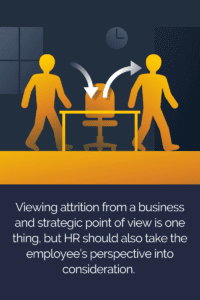As employees grow in their careers, turnover becomes inevitable. But how can HR prepare itself for constant rotation?
By Simon Kent
The sight of talent leaving can be worrying. Having spent time, money, and effort in finding, hiring, and developing great employees, organisations may not want to see them go. But at the same time, no one wants a business that’s stuck in a rut or a team that’s stale. Add to this, very few employees want to stay in the same place for a long time. “In this day and age, it’s very rare to see employees spend their entire careers working for just one organisation,” says Debbie Brown, HR director of Canon UK and Ireland. “People might want to move to the next step in their career, look for a new challenge entirely, or move out of their current industry. It is therefore of utmost importance that businesses support their employees’ growth in the best way possible in order to boost retention and allow them to thrive.”
There is a dividing line between reasonable and problematic staff turnover, however, identifying that line is not straightforward. Lee
Goulding advises that HR leaders take a “mature” approach to employee attrition.
“Treating leavers well leaves a good feeling behind with the remaining staff – there’s nothing worse than a bad aftertaste which dulls team morale – and doesn’t burn any bridges.” he explains. “This same employee may return armed with better skills and performance, or even become a competitor later down the line.” However, attrition should never be taken lightly. HR must keep on top of the who, the what, and the why, ready to spot and respond to any worrying trends.
“Staff turnover can be worrying at any level,” says Gudgeon, noting that the perception that the higher up in an organisation it occurs, the worse it is, is not always true. “It’s important that all companies, no matter their size, have agility and succession planning strategies in place. They need to ensure the knowledge and skills they have don’t just get up and leave the building when an employee hands in their notice.” Gudgeon also says careful planning can help track the cost of the loss of an employee should they leave.
Viewing attrition from a business and strategic point of view is one thing, but HR should also take the employee’s perspective into consideration. Lauren Wakeling, UK country manager at CoursesOnline, advocates the use of staff surveys and exit interviews to build an understanding of why people stay or go. “This information can be very valuable for developing your future business strategy as well as plotting what benefits and development plans can be implemented for staff going forward,” she says.
Kate Palmer, HR advice and consultancy director at Peninsula also advocates looking to the workforce for an insight into why people decide to leave and therefore whether there is an underlying issue.
“Resignations within an organisation are inevitable and should be expected,” she says. “Employees will leave the business for a variety of different reasons, with the most obvious end-stage being retirement.”
As Palmer notes, employees who leave provide space for new talent to progress, which should result in positive change. “Without fresh ideas and opinions, employers can suffer from outdated working practices,” she says. But she also notes, the best-case scenario is that any leaver does so on good terms. “When they do, a healthy turnover can be created and keeps the door open for them to return in the future if other opportunities fell through. To do this, it’s useful for employers to conduct exit interviews and communicate their appreciation for the person’s hard work and commitment.”
This approach is supported by Canon’s Brown, and in her business, the issue of retention has been integrated into the overall employee support and development programme. “We offer a comprehensive support scheme for our employees, which helps to drive employee development and career progression,” she explains. “Now that business is returning to some form of normal, we have seen a number of our staff looking for fresh and exciting opportunities. Whilst inevitably, some employees have moved to new organisations, we are fortunate to be a large business with many different departments. This gives our staff the opportunity to move into new roles and functions internally in order to develop their career at Canon and learn new skills.”
Dr. Andy Brown, CEO at leadership and engagement consultancy ENGAGE, advises businesses to address the main challenges around this area: the talent a business needs to keep and the main drivers of retention. People may leave for several reasons, including low performance, poor culture fit, or lacking the right skills.

These elements include engagement with their employer; their work; organisational goals and purpose; and their clients.
By analysing an employee’s position in these regards, Dr. Brown has identified five core employee groups.
Champions: those who are fully engaged
Disconnecteds: those who are not engaged and are not looking to stay.
Mercenaries: those who are highly engaged with what the organisation is trying to achieve but have a low likelihood of staying with the company.
Hostages: those who are not engaged with what the company is trying to achieve but are happy to stay for the long-term, perhaps due a comfortable environment or high reward.
Fence sitters: unsure about whether they should stay or leave.
It is crucial to understand that these categories are not permanent states. For example, with the right encouragement, resources, and communication, the fence sitters could become champions. “Understanding how these groups are spread across your organisation means you can focus your retention and development efforts on the groups that are most critical in driving business performance,” says Dr. Brown. “As a result, turnover becomes ‘healthy’ by default because it is focused on delivering business results.”
In other words, whilst employees will naturally leave the business for new pastures, their decisions may not only be best for them, but they could be best for your business, too.














